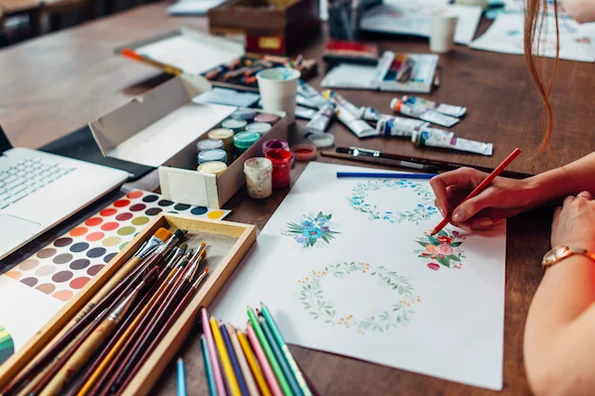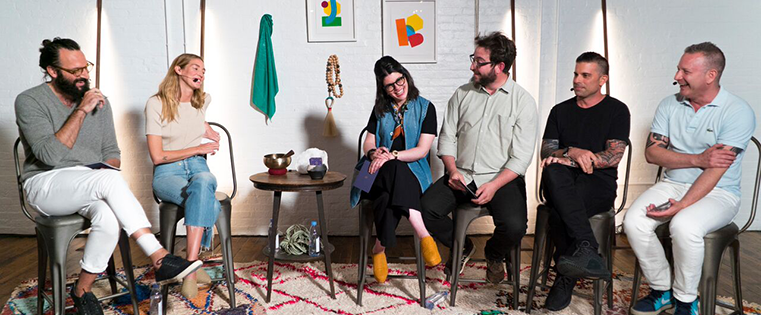How to be a More Creative Person:
- Start with a morning freewrite.
- Take a creative course.
- Brainstorm while you exercise.
- Travel to other places.
- Channel your inner child.
- Join a coworking space.
- Incorporate breaks into every work day.
- Connect with creative people.
- Keep a doodle journal at your desk.
- Unwind by watching funny content.
- Listen to music while you work.
"Everything’s already been thought of."

"I don't even know where to start."
"I’m just not a creative person."
We've all had those frustrating moments -- when when we're expected to come up with a brilliant new idea, but no matter how much we squint at our computer screens, we just can't seem to think of anything good.
That's when we look over at our peers who are "creative types" and wonder why we didn't inherit any of those creative genes ourselves.
But it may be that we're looking at it wrong. In fact, many psychologists argue that creativity isn't something people are born with; it's actually a skill that can be learned. And, as with any other skill, you can only get better at it with practice. The brain is like muscle that needs to be developed -- in this case, using cognitive exercises.
So: What can we do to exercise that creative muscle when we're struggling to come up with new ideas? Everyone has their own ways they like to "get in shape." To help you get started, here are 11 different ways to jog your creative thinking.
11 Ways to Jumpstart Your Creativity
1) Start with a morning freewrite.
We all have days when walk in to the office in the morning and all we can think about is our jam-packed to-do list. But focusing solely on how much we have to get done can stress us out, and it can even cause us to lose perspective on our own thinking.
On days like this, one way to refocus is by doing a morning freewrite. According to a study from Harvard Business School Professor Teresa Amabile, regular workplace journaling allows you to rediscover your perspective and become more productive.
So instead of jumping right into your projects when you get into the office, block off ten minutes for a digital detox and grab a notebook and paper to just write. Unlike a blog or some other public-facing piece of content, a physical journal is your own personal compilation of thoughts that don’t need to make sense to anyone but you. Writing in a more free-form style will allow your creative juices to flow, while also forcing you to put your thoughts into written words.
Don't know where to start with freewriting? Check out Twords' prompt library, or subscribe to Daily Page to get a writing prompt emailed to you every morning. Here are some more prompt ideas from my colleague Megan Conley:
- Recently, I’m struggling with ...
- If I had more time in the day, I’d use it to ...
- Today, I’ll relieve stress by ...
- I feel out of my comfort zone when ...
- My work is motivated by ...
- This week, I’m thankful for ...
- Today, I should avoid ...
- I feel fulfilled at work when ...
- From my team, I’m proud of ...
- I work best when ...
2) Take a creative course.
If you're the kind of person who prefers guided instruction, taking a creative course could be the right way to direct your creativity.
Creative courses could be anything from creative writing to photo and video to music, art, and design. Regardless which course you take, you'll be exposed to different ways of thinking and approaches to working that you can apply to your own work. Plus, it may help you uncover some of your strengths and work on your weaknesses.
It'll also surround you with other people who share the goal of developing their creative skills. You can learn from your peers and review each other’s work to get a fresh perspective on your own ideas. And if you’re someone who is too nervous to ask for help in the office, a classroom setting could give you the opportunity to open up to others by way of workshop-style critiques. By sharing your ideas with others, you’ll be forced to find ways to formulate your thoughts into words and visuals, while learning to handle critique from others.
A few free online courses to start with include Creative Live, MIT OpenCourseWare, Creative Writing Now, and Stanford OpenEdEx.
Now, courses may not be for everyone -- especially if you feel like structure is a hinder to your creative flow. But if you feel like you're lacking direction in your thinking, it may be worth a try.
3) Brainstorm while you exercise.
If you feel like you’re working your brain hard and still coming out empty-handed, try pushing yourself physically for thirty minutes or so. Research shows that exercise can be linked to more creative thinking. One study that focused on how moderate exercise influences participants’ performance on different thinking tasks found that exercising regularly may train your cognitive thinking and creativity in a healthy way.
“Much more of the brain is devoted to movement than to language. Language is only a little thing sitting on top of this huge ocean of movement,” says Neurologist Oliver Sacks.
Take 30 minutes out of your day to go for a run, do an energizing yoga flow, or practice some deskercises. It’ll benefit both your body and mind.
4) Travel to other places.
Since your creativity is related to how your brain is wired, it’s important to keep your mind stimulated by new sights, sounds, tastes, smells, and experiences. Expose yourself to an entirely different point of view through a new cultural experience. Keeping your sense sharp allows the synapses in your brain to think in new ways.
“Foreign experiences increase both cognitive flexibility and depth and integrativeness of thought, the ability to make deep connections between disparate forms,” says Adam Galinsky, a professor at Columbia Business School, whose research focuses on the cognitive connection between international travel and creativity.
He emphasizes the importance of not just going to different places, but also immersing yourself into their culture. By engaging with the local art, cuisine, and people, you allow yourself to really learn new ways of thinking that you can later apply to your own ideas.
5) Channel your inner child.
Children are considered "naturally creative" -- only because they know no limits to their creativity. Since children are willing to go in any direction with their creativity, they don’t hold back. Channel this mentality, especially when it comes to taking a completely different direction with your work. Instead of being concerned or self-conscious that your work isn’t good enough, be willing to take risks to push your creative limits.
Most importantly, have fun with your work. A child sees everything as an adventure and makes the most of every moment. Instead of being concern about all your responsibilities at once, focus all your energy into one project at a time so you can put your best foot forward.
6) Join a coworking space.
A study at University of Michigan found two key ways coworking spaces create unique opportunities for creativity: flexibility and autonomy. A lot of it has to do with the physical setup of the space. The flexibility to control your space to suit your personal preference encourages creativity. Some studies have shown that have the ability to customize your workspace leads to higher levels of productivity. Your creative funk may be caused by working in an environment that is simply not conducive to your personal style of work.
Plus, the proximity to others means ample opportunity for collaboration. Collaboration can be a catalyst for innovation, and coworking spaces are great ways to throw yourself into a new environment with like-minded, innovative people.
Not sure where to find coworking space near you? Start by entering your city into DeskSurfing.net to do a local search.
7) Incorporate breaks into every work day.
Ever noticed that some of your best ideas come to you at the most random times, like the car or the shower? There's a reason for that: These breaks allow your mind to continue to work on these ideas without getting stuck in a funk where you can’t organize your thoughts.
As Adrian Furnman, Ph.D describes in a Psychology Today article, it’s important to give your thinking "incubation time" once you’ve been actively working on an idea for some time.
Brian Halligan, HubSpot's own CEO and co-founder, is a big advocate for naps at the workplace. He actually finds his best ideas come to him when he just falling asleep or just waking up. In an interview with the New York Times, he said he pushes to make the office into an environment where employees can "work less and think more" by providing nap rooms to encourage folks to take a break. This, he says, will help spark creativity.
Make sure to allow yourself to block off designated break sessions in your calendar so you don’t lose that time after being scheduled for endless, back-to-back meetings.
8) Connect with creative people.
When you’ve hit a wall with your own ideas, it may be time to tap into the creativity of others. Surrounding yourself with people with whom you can share and get feedback on your ideas and opinions is not only good for your creativity, it's good for your career. These different points of view can act as fresh perspective on a project you’ve been staring at for too long.
Not only can creative people give you feedback on your projects, their own drive will keep you motivated to do your best work. A healthy dose of competition could be just what the doctor ordered when you need to force yourself to really channel your inner creative spirit.
This rings especially true when these connection challenge your way of thinking. If you surround yourself with like-minded people, you could fall into the trap of confirmation bias where you never see the faults in your own work because everyone already agrees with you. Although it could be hard to take this critique, it’ll force you to think in ways you never thought of before.
To start networking with other creative minds, you can explore people’s work in platforms like Behance or Instagram. If you’re looking to connect with people in person, attend conferences and networking events related to both your industry and your interests.
9) Keep a doodle journal at your desk.
Are you a visual thinker? If so, you might find it hard to find a direction with your ideas when you’re limited to the four corners of your screen. Change your routine and grab a pencil and paper to let your ideas free form in a more physical outlet. A blank sheet of paper or whiteboard may just be the best outlet to allow you to organize your thought process into one space.
According to Sunni Brown, author of The Doodle Revolution, “Even if you’re just scribbling in the margins, you’re lighting up different networks in your brain and when you do that, you’re engaging different information."
Creating visual maps of all your different thoughts allows you to see the relationship between your ideas. Physically writing it down takes your ideas a step further and forces you to put them into words and physical shapes. If you can see your thought process, it will be easier to understand the direction you’ll want to go in.
10) Unwind by watching funny content.
Have you hit the point in your creativity block where you’re spending hours watching cat videos? Turns out those cat videos may actually be helpful. Research shows there's a strong correlation between humor and creativity. A laugh can actually bring you closer to those moments of inspiration. Humor also puts you in a better mood, allowing you to think more freely and better solve creative problems.
If you look at your project from a more lighthearted perspective, you’ll allow yourself to have a fresh perspective on the problem at hand. Start with this list of funny tweets and social media posts that real brands have posted for inspiration.
11) Listen to music while you work.
Need a way to hone in on your work without zoning out? Although there's been a lot of debate over whether listening to music will actually increase your intelligence over time (a theory often called the Mozart Effect), there are still productivity benefits to tuning in. Listening to music can help you focus on whatever task you're currently doing. It can also put you in a better mood, and even calm your nerves if you're feeling anxious.
Certain forms of music can help channel your creativity better than others and tune out the noises of the office. While music with extreme changes of pace or lyrics can be distracting, ambient music can help increase processing levels and and promote creative thinking.
Everyone has their own taste in music, but some of the most work conducive genres include classical, electronic, and even video game soundtracks. Be sure to check out HubSpot's own list list of recommended productive playlists.
One new practice can work for you differently over time if you start to get bored of it. If you ever start to feel a practice has become too routine for you, revisit this post to try out another idea.
What else do you do to channel your inner creativity? Share with us in the comments.










